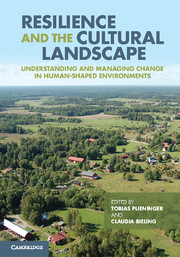 Resilience and the Cultural Landscape
Resilience and the Cultural Landscape Published online by Cambridge University Press: 05 November 2012
Introduction
Cultural landscapes are shaped by society and nature alike. As societies and nature are dynamic, change is an inherent characteristic of cultural landscapes. Understanding these changes is one of the prime goals of the recently emerged field of land change science (Turner et al., 2007; Turner & Robbins, 2008). Although a unifying theory of land change does not yet exist, significant theoretical advances have been made (Briassoulis, 2000; Lambin et al., 2006; Walker & Solecki, 2004).
Studies of landscape change increasingly go beyond a merely descriptive approach and adopt an analytical perspective. In the context of the topics presented in this book, this means that challenging questions like ‘Why does a certain landscape show traits of resilient behaviour in regard to certain aspects and over a defined period?’ are addressed. One way of meeting this challenge is to systematically study the landscape changes and the factors responsible for the observed change and persistency. These so-called driving forces of landscape change (Bürgi et al., 2004) can be analysed for all kinds of cultural or natural landscapes.
Both terms, cultural landscapes and resilience, have a normative character. The term resilience is usually positively used, but resilient behaviour of landscapes is not desirable per se (Cumming, 2011). For example, a land manager trying in vain to restore a degraded cultural landscape will perceive resilience of this landscape as problematic. The term cultural landscape is partly value-laden in quite a similar way. On the one hand, all landscapes that are shaped by anthropogenic activities can be called cultural landscapes, many of which underwent radical changes in the last decades. In these cases, no specific positive connotation of the term cultural landscapes is intended.
To save this book to your Kindle, first ensure [email protected] is added to your Approved Personal Document E-mail List under your Personal Document Settings on the Manage Your Content and Devices page of your Amazon account. Then enter the ‘name’ part of your Kindle email address below. Find out more about saving to your Kindle.
Note you can select to save to either the @free.kindle.com or @kindle.com variations. ‘@free.kindle.com’ emails are free but can only be saved to your device when it is connected to wi-fi. ‘@kindle.com’ emails can be delivered even when you are not connected to wi-fi, but note that service fees apply.
Find out more about the Kindle Personal Document Service.
To save content items to your account, please confirm that you agree to abide by our usage policies. If this is the first time you use this feature, you will be asked to authorise Cambridge Core to connect with your account. Find out more about saving content to Dropbox.
To save content items to your account, please confirm that you agree to abide by our usage policies. If this is the first time you use this feature, you will be asked to authorise Cambridge Core to connect with your account. Find out more about saving content to Google Drive.